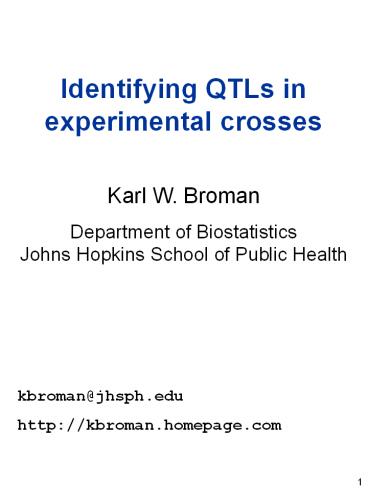Identifying QTLs in experimental crosses - PowerPoint PPT Presentation
1 / 20
Title:
Identifying QTLs in experimental crosses
Description:
n (100 1000) F2 progeny. yi = phenotype for individual i. gij = genotype for indiv i at marker j ... Estimate epistatic effects. Analysis of single QTL: ... – PowerPoint PPT presentation
Number of Views:22
Avg rating:3.0/5.0
Title: Identifying QTLs in experimental crosses
1
Identifying QTLs in experimental crosses
Karl W. Broman Department of Biostatistics Johns
Hopkins School of Public Health
kbroman_at_jhsph.edu http//kbroman.homepage.com
1
2
F2 intercross
20
80
2
3
Distribution of the QT
P1
P2
F1
F2
3
4
Data
- n (1001000) F2 progeny
- yi phenotype for individual i
- gij genotype for indiv i at marker j
- (AA, AB or BB)
- Genetic map of the markers
- Phenotypes of parentals and F1
4
5
D1M1
5
6
Single QTL analysis
Marker D1M1
Additive effect
Dominance deviation
Prop'n var explained
6
7
D2M2
7
8
Single QTL analysis
Marker D2M2
8
9
Is it real?
Hypothesis testing Null hypothesis, H0 no
QTL P-value Pr(LOD gt observed no QTL) Small P
(large LOD) ? Reject H0 (Good) Large P (small
LOD) ? Fail to reject H0 (Bad) Generally want P lt
0.05 or lt 0.01 P ? 0.049 ? P ? 0.051 LOD ? 3.01
? LOD ? 2.99
9
10
A picture
Distribution of LOD given no QTL
P-value area
Observed LOD
10
11
Multiple testing
? We're doing 200 tests (one at each marker
correlated due to linkage) ? Imagine the tests
were uncorrelated, and that H0 is true (there is
no QTL) Toss 200 biased coins Heads ? Reject H0
(falsely conclude that there is a
QTL) Pr(Heads) 5
Ave no. heads in 200 tosses 10 Pr(at least one
head in 200 tosses) ? 100
11
12
A new picture
Distribution of max LOD given no QTL
P ? 25
Observed LOD
12
13
Interval mapping (Lander and Botstein 1989)
Interpolation between markers At each point,
imagine a putative QTL and maximize Pr(data
QTL, parameters) Great for dealing with missing
genotype data important for widely spaced
markers
13
14
Power
- Power Pr(Identify a QTL there is a QTL)
- Power depends on
- Sample size
- Size of QTL effect (relative to resid. var.)
- Marker density
- Level of statistical significance
- Consider
- Pr(detect a particular locus)
- Pr(detect at least one locus)
14
15
n 100 h2 20 Power 16
n 400 h2 20 Power 90
n 400 h2 10 Power 41
n 100 h2 10 Power 3
15
16
Selection bias
If the power to detect a particular locus is not
super high, its estimated effect (when it is
identified) will be biased
Power ? 90 ? Bias ? 2 Power ? 45 ?
Bias ? 20 Power ? 5 ? Bias ? 100
16
17
Multiple QTLs
- It is often important to consider multiple QTLs
simultaneously - Increase power by reducing residual variation
- Separate linked loci
- Estimate epistatic effects
- Analysis of single QTL
- analysis of variance (ANOVA) or simple linear
regression - Analysis of multiple QTL
- multiple linear regression, possibly with
interaction terms possibly using tree- based
models - A key issue Things are more complicated than
"Is there a QTL here or not?"
17
18
An example
Full model
Additive model
18
19
A tree-based model
19
20
Summary
- LOD scores
- Hypothesis testing
- Null hypothesis
- P-values
- Significance levels
- Adjustment for multiple tests
- Power
- To identify a particular locus
- To identify at least one locus
- Selection bias
- Multiple QTLs
- Increase power
- Separate linked loci
- Estimate epistasis
- Things get complicated
20































